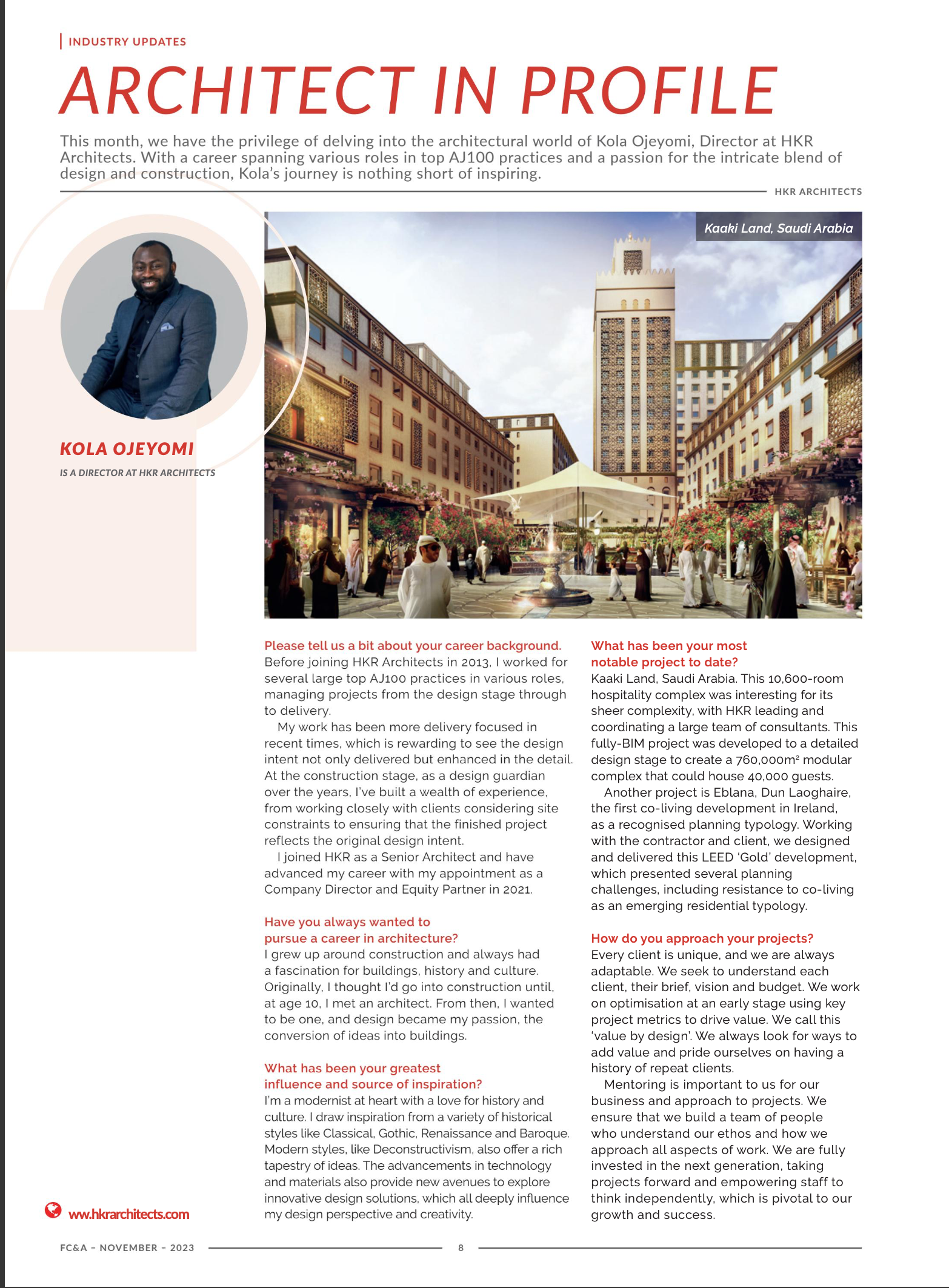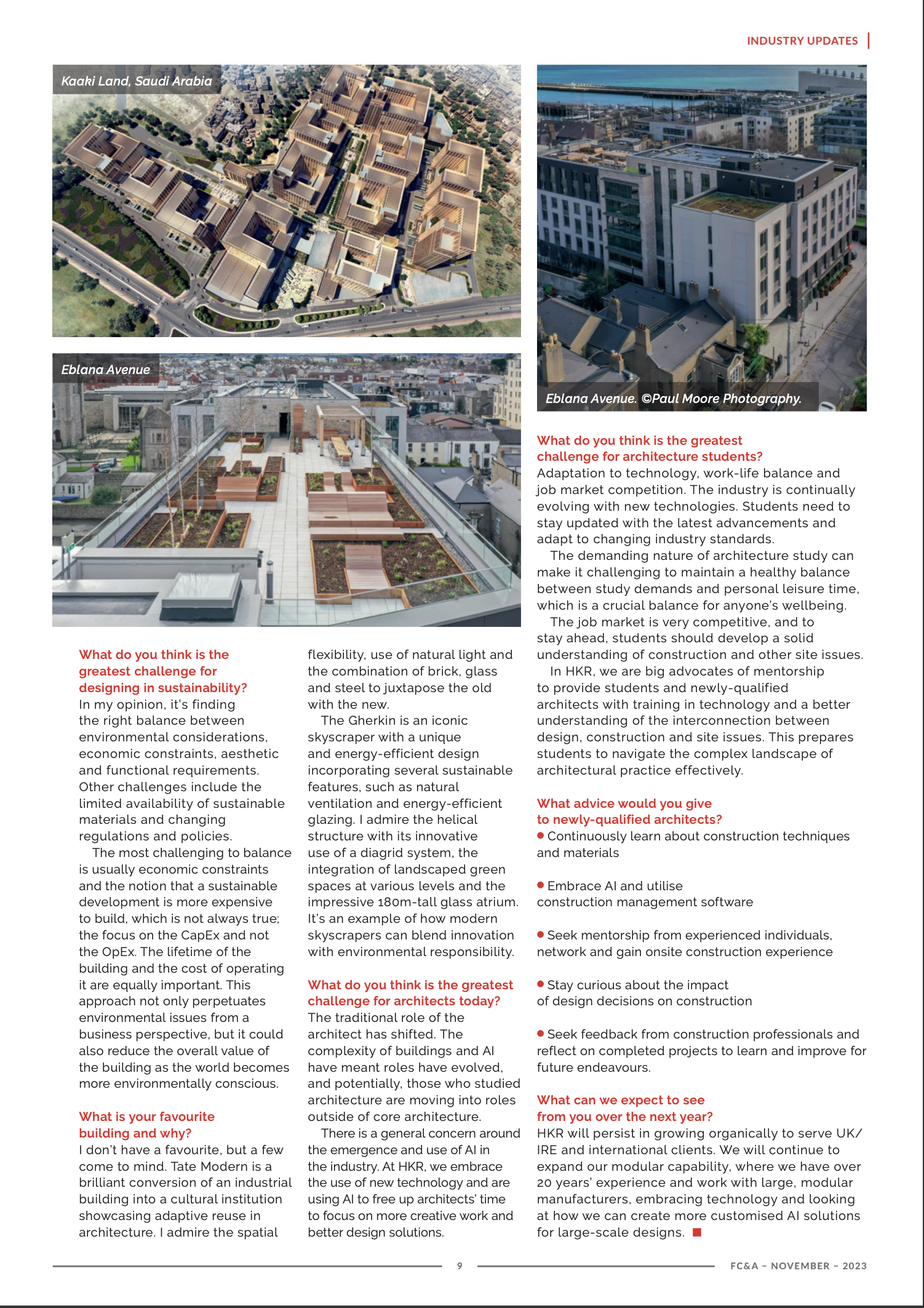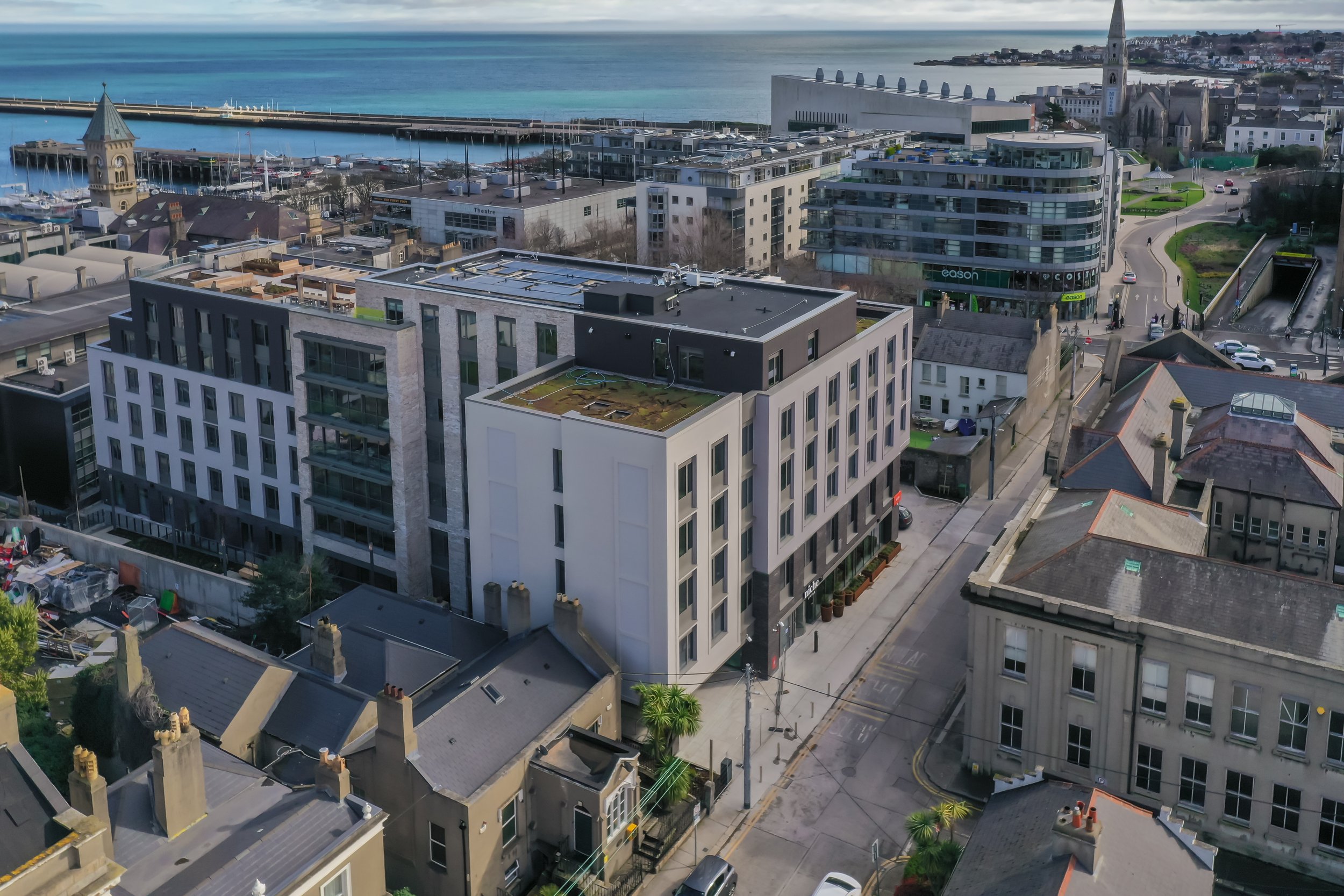Director featured in FC&A Magazine - Architect in Profile
We are delighted to see our Director, Kola Ojeyomi featured as Architect in Profile in this month’s Future Constructor and Architect Magazine. Read the article in full below.
Please tell us a bit about your career background
Before joining HKR Architects in 2013 I worked for several large top AJ100 practices in various roles, managing projects from design stage through to delivery.
My work has been more delivery focused in recent times, which is rewarding to see the design intent not only delivered but enhanced in the detail. At construction stage as design guardian over the years, I’ve built a wealth of experience from working closely with clients considering site constraints to ensuring that the finished project reflects the original design intent.
I joined HKR as Senior Architect and have advanced my career with my appointment as a Company Director and Equity Partner in 2021.
Had you always wanted to pursue a career in architecture/design?
I grew up around construction and always had a fascination for buildings, history, and culture. Originally, I thought I’d go into construction until, aged 10, I met an architect. From then I wanted to be one and design became my passion, the conversion of ideas into buildings.
Who/what has been your greatest influence and source of inspiration?
I’m a modernist at heart with a love for history and culture. I draw inspiration from a variety of historical styles like Classical, Gothic, Renaissance, Baroque, and modern styles like deconstructivism offer a rich tapestry of ideas. The advancements in technology and materials also provide new avenues to explore innovative design solutions, which all deeply influence my design perspective and creativity.
What has been your most notable project to date?
Kaaki Land, Saudi Arabia. This 10,600-room hospitality complex was interesting for its sheer complexity with HKR leading and coordinating a large team of consultants. This fully BIM project was developed to detailed design stage to create a 760,000sqm modular complex which could house 40,000 guests.
Another project, Eblana, Dun Laoghaire, the first Co-Living development in Ireland, as a recognised planning typology. Working with the contractor and client we designed and delivered this LEED Gold development which presented several planning challenges including resistance to Co-Living as an emerging residential typology.
How do you approach your projects?
Every client is unique, and we are always adaptable. We seek to understand each client, their brief, vision, and budget. We work on optimisation at an early stage using key project metrics to drive value. We call this ‘value by design’. We always look at ways to add value and pride ourselves on having a history of repeat clients.
Mentoring is important to us, for our business and approach to projects. We ensure that we build a team of people that understand our ethos and how we approach all aspects of work. We are fully invested in the next generation taking projects forward and empower staff to think independently, which is pivotal to our growth success.
What do you think is the greatest challenge for designing in sustainability?
In my opinion it’s finding the right balance between environmental considerations, economic constraints, aesthetic, and functional requirements. Other challenges include limited availability of sustainable materials and changing regulations and policies.
The most challenging to balance is usually economic constraints and the notion that a sustainable development is more expensive to build, which is not always true; the focus on the CapEx and not the OpEx. The lifetime of the building and the cost of operating it are equally important. This approach not only perpetuates environmental issues, from a business perspective, it could also reduce the overall value of the building as the world becomes more environmentally conscious.
What is your favourite building and why?
I don’t have a favourite, but a few come to mind. Tate Modern is a brilliant conversion of an industrial building into a cultural institution showcasing adaptive reuse in architecture. I admire the spatial flexibility, use of natural light, the combination of brick, glass, and steel to juxtapose the old with the new.
The Gherkin, an iconic skyscraper with a unique and energy-efficient design which incorporates several sustainable features, such as natural ventilation and energy-efficient glazing. I admire the helical structure with its innovative use of a "diagrid" system, the integration of landscaped green spaces at various level, the impressive 180-meter-tall glass atrium. It’s an example of how modern skyscrapers can blend innovation with environmental responsibility.
What do you think is the greatest challenge for architects today?
The traditional role of the architect has shifted. The complexity of buildings and AI have meant roles have evolved and potentially those who studied architecture are moving into roles outside of core architecture.
There is a general concern around the emergence and use of AI in the industry. At HKR we embrace the use of new technology, and are using AI to free up architects time to focus on more creative work and better design solutions
What do you think is the greatest challenge for architecture students?
Adaptation to technology, work-life balance, and job market competition. The industry is continually evolving with new technologies. Students need to stay updated with the latest advancements and adapt to changing industry standards.
The demanding nature of architecture study can make it challenging to maintain a healthy balance between study demands and personal leisure time, which is a crucial balance for anyone’s well-being.
The job market is very competitive and to stay ahead students should develop a solid understanding of construction and other site issues.
In HKR, we are big advocates of mentorship to provide students and newly qualified architects with training in technology, a better understanding of the interconnection between design, construction, and site issues, this prepares students to effectively navigate the complex landscape of architectural practice.
What advice would you give to newly qualified architects?
· Continuously learning about construction techniques and materials.
· Embrace AI and utilize construction management software.
· Seek mentorship from experienced individuals, network and gain on-site construction experience.
· Stay curious about the impact of design decisions on construction.
· Seek feedback from construction professionals and reflect on completed projects to learn and improve for future endeavours.
What can we expect to see from you over the next year?
HKR will continue to grow organically to serve UK/IRE and international clients. We will continue to expand our modular capability, where we have over 20 years’ experience and work with large modular manufacturers, embracing technology, looking at how we can create more customised AI solution for large scale designs.




